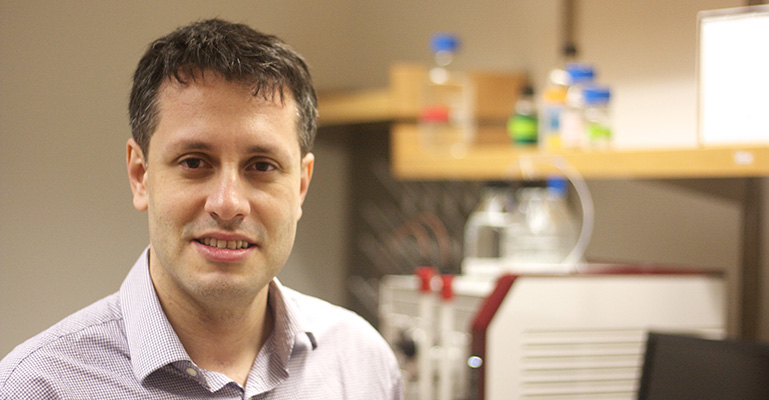The Faculty

Engin Özkan
Associate Professor
Affiliation: Biochemistry and Molecular Biology
Emaileozkan@uchicago.edu
Websitehttp://ozkan.uchicago.edu
Focus
Biochemical basis of nervous system development, protein-protein interaction, strutural biology of extracellular proteins
Biography
1999 Bilkent University, Ankara, Turkey B.S. 06/99
2006 U of Texas Southwestern Medical Center at Dallas Ph.D. 5/06
2013 Stanford University Postdoctoral 6/13
2014-present Assistant Professor, Department of Biochemistry and Molecular Biology, The University of Chicago
Awards and accolades
2015 - Klingenstein-Simons Neuroscience Fellow
2016 - Alfred P. Sloan Research Fellow in Neuroscience
Research Interests
Our laboratory is working on understanding how specific cellular connections are made within complex, multi-cellular organisms. Our approach is molecular: We are, first, working on discovering protein-protein complexes that are likely to drive specificity and function of cellular adhesions, using high-throughput approaches. Then, we take a structural approach to elucidate how such complexes work, through biophysics and x-ray crystallography, in collaboration with model-organism geneticists. We are especially interested in molecular cues and “identification tags” that determine the wiring networks in the nervous system.
In the long term, we are hoping to make an impact in several fields: We will significantly contribute to revealing the “Extracellular Interactome”, a large section of the map of protein-protein interactions. We are actively working to identify and characterize cell surface receptors that partake in axonal guidance and pruning, synaptogenesis, and synaptic function. Finally, we are trying to understand the molecular “rules” of how protein-protein complexes can create cellular adhesions.
Publications
Cheng S, Park Y, Kurleto JD, Jeon M, Zinn K, Thornton JW, Özkan E. Family of neural wiring receptors in bilaterians defined by phylogenetic, biochemical, and structural evidence. Proc Natl Acad Sci U S A. 2019 05 14; 116(20):9837-9842.
Ranaivoson FM, Turk LS, Ozgul S, Kakehi S, von Daake S, Lopez N, Trobiani L, De Jaco A, Denissova N, Demeler B, Özkan E, Montelione GT, Comoletti D. A Proteomic Screen of Neuronal Cell-Surface Molecules Reveals IgLONs as Structurally Conserved Interaction Modules at the Synapse. Structure. 2019 06 04; 27(6):893-906.e9.
Stedden CG, Menegas W, Zajac AL, Williams AM, Cheng S, Özkan E, Horne-Badovinac S. Planar-Polarized Semaphorin-5c and Plexin A Promote the Collective Migration of Epithelial Cells in Drosophila. Curr Biol. 2019 03 18; 29(6):908-920.e6.
Cheng S, Ashley J, Kurleto JD, Lobb-Rabe M, Park YJ, Carrillo RA, Özkan E. Molecular basis of synaptic specificity by immunoglobulin superfamily receptors in Drosophila. Elife. 2019 01 28; 8.
Li H, Watson A, Olechwier A, Anaya M, Sorooshyari SK, Harnett DP, Lee HP, Vielmetter J, Fares MA, Garcia KC, Özkan E, Labrador JP, Zinn K. Deconstruction of the beaten Path-Sidestep interaction network provides insights into neuromuscular system development. Elife. 2017 08 15; 6.
Zinn K, Özkan E. Neural immunoglobulin superfamily interaction networks. Curr Opin Neurobiol. 2017 08; 45:99-105.
Cheng S, Seven AB, Wang J, Skiniotis G, Özkan E. Conformational Plasticity in the Transsynaptic Neurexin-Cerebellin-Glutamate Receptor Adhesion Complex. Structure. 2016 12 06; 24(12):2163-2173.
Dong X, Chiu H, Park YJ, Zou W, Zou Y, Özkan E, Chang C, Shen K. Precise regulation of the guidance receptor DMA-1 by KPC-1/Furin instructs dendritic branching decisions. Elife. 2016 Mar 14; 5.
Carrillo RA, Özkan E, Menon KP, Nagarkar-Jaiswal S, Lee PT, Jeon M, Birnbaum ME, Bellen HJ, Garcia KC, Zinn K. Control of Synaptic Connectivity by a Network of Drosophila IgSF Cell Surface Proteins. Cell. 2015 Dec 17; 163(7):1770-1782.
Hara M, Özkan E, Sun H, Yu H, Luo X. Structure of an intermediate conformer of the spindle checkpoint protein Mad2. Proc Natl Acad Sci U S A. 2015 Sep 08; 112(36):11252-7.
Maro GS, Gao S, Olechwier AM, Hung WL, Liu M, Özkan E, Zhen M, Shen K. MADD-4/Punctin and Neurexin Organize C. elegans GABAergic Postsynapses through Neuroligin. Neuron. 2015 Jun 17; 86(6):1420-32.
Ho CC, Guo N, Sockolosky JT, Ring AM, Weiskopf K, Özkan E, Mori Y, Weissman IL, Garcia KC. "Velcro" engineering of high affinity CD47 ectodomain as signal regulatory protein a (SIRPa) antagonists that enhance antibody-dependent cellular phagocytosis. J Biol Chem. 2015 May 15; 290(20):12650-63.



